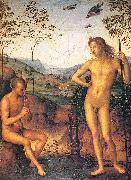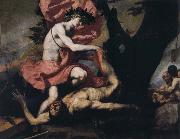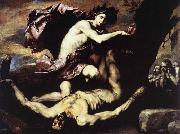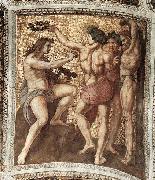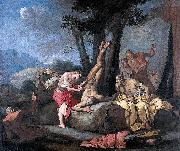Wholesale Oil Painting Reproductions No Minimum and Door to Door! |
|||||||||||
|
|
|||||||||||

|
|||||||||||
|
|
|
||||||||
All PERUGINO, Pietro Oil Paintings |
||||||||
|
|
||||||||
|
|
||||||||
|
Artist Introduction: Italian painter, Umbrian school (b. 1450, Citta della Pieve, d. 1523, Perugia).
Italian painter and draughtsman. He was active in Perugia, Florence and Rome in the late 15th century and early 16th. Although he is now known mainly as the teacher of Raphael, he made a significant contribution to the development of painting from the style of the Early Renaissance to the High Renaissance. The compositional model he introduced, combining the Florentine figural style with an Umbrian use of structure and space, |
||||||||
|
|
||||||||
|
Apollo and Marsyas Painting ID:: 19842 |
Panel
Mus??e du Louvre, Paris. |
|||||||
Height Width |
INS/CM Quality |
|||||||
|
X |
| |||||||
|
|
||||||||
All Jusepe de Ribera Oil Paintings |
||||||||
|
|
||||||||
|
|
||||||||
|
Artist Introduction: 1591-1652
Spanish
Jusepe de Ribera Galleries
Jusepe de Ribera (January 12, 1591 - 1652) was a Spanish Tenebrist painter and printmaker, also known as Jos?? de Ribera in Spanish and as Giuseppe Ribera in Italian. He was also called by his contemporaries and early writers Lo Spagnoletto, or "the Little Spaniard". Ribera was a leading painter of the Spanish school, although his mature work was all done in Italy.
In his earlier style, founded sometimes on Caravaggio and sometimes on the wholly diverse method of Correggio, the study of Spanish and Venetian masters can be traced. Along with his massive and predominating shadows, he retained from first to last a great strength in local coloring. His forms, though ordinary and sometimes coarse, are correct; the impression of his works gloomy and startling. He delighted in subjects of horror. In the early 1630s his style changed away from strong contrasts of dark and light to a more diffused and golden lighting. Salvator Rosa and Luca Giordano were his most distinguished followers, who may have been his pupils; others were also Giovanni Do, Enrico Fiammingo, Michelangelo Fracanzani, and Aniello Falcone, who was the first considerable painter of battle-pieces.
Among Ribera's principal works could be named "St Januarius Emerging from the Furnace" in the cathedral of Naples; the "Descent from the Cross" in the Certosa, Naples, the "Adoration of the Shepherds" (a late work, 1650), now in the Louvre; the "Martyrdom of St Bartholomew" in the Prado; and the "Pieta" in the sacristy of San Martino, Naples. His mythologic subjects are often as violent as his martyrdoms: for example, "Apollo and Marsyas", with versions in Brussels and Naples, or the "Tityus" in the Prado . The Prado and Louvre contain numbers of his paintings; the National Gallery, London, three. He executed several fine male portraits and a self-portrait. He was an important etcher, the most significant Spanish printmaker before Goya, producing about forty prints, nearly all in the 1620s. |
||||||||
|
|
||||||||
|
|
Apollo and Marsyas Painting ID:: 32908 |
mk84
1637.Brussels
canvas
202x255cm
|
||||||
Height Width |
INS/CM Quality |
|||||||
|
X |
| |||||||
|
|
||||||||
All Jusepe de Ribera Oil Paintings |
||||||||
|
|
||||||||
|
|
||||||||
|
Artist Introduction: 1591-1652
Spanish
Jusepe de Ribera Galleries
Jusepe de Ribera (January 12, 1591 - 1652) was a Spanish Tenebrist painter and printmaker, also known as Jos?? de Ribera in Spanish and as Giuseppe Ribera in Italian. He was also called by his contemporaries and early writers Lo Spagnoletto, or "the Little Spaniard". Ribera was a leading painter of the Spanish school, although his mature work was all done in Italy.
In his earlier style, founded sometimes on Caravaggio and sometimes on the wholly diverse method of Correggio, the study of Spanish and Venetian masters can be traced. Along with his massive and predominating shadows, he retained from first to last a great strength in local coloring. His forms, though ordinary and sometimes coarse, are correct; the impression of his works gloomy and startling. He delighted in subjects of horror. In the early 1630s his style changed away from strong contrasts of dark and light to a more diffused and golden lighting. Salvator Rosa and Luca Giordano were his most distinguished followers, who may have been his pupils; others were also Giovanni Do, Enrico Fiammingo, Michelangelo Fracanzani, and Aniello Falcone, who was the first considerable painter of battle-pieces.
Among Ribera's principal works could be named "St Januarius Emerging from the Furnace" in the cathedral of Naples; the "Descent from the Cross" in the Certosa, Naples, the "Adoration of the Shepherds" (a late work, 1650), now in the Louvre; the "Martyrdom of St Bartholomew" in the Prado; and the "Pieta" in the sacristy of San Martino, Naples. His mythologic subjects are often as violent as his martyrdoms: for example, "Apollo and Marsyas", with versions in Brussels and Naples, or the "Tityus" in the Prado . The Prado and Louvre contain numbers of his paintings; the National Gallery, London, three. He executed several fine male portraits and a self-portrait. He was an important etcher, the most significant Spanish printmaker before Goya, producing about forty prints, nearly all in the 1620s. |
||||||||
|
|
||||||||
|
|
Apollo and Marsyas Painting ID:: 51273 |
1637
Oil on canvas,
182 x 232 cm |
||||||
Height Width |
INS/CM Quality |
|||||||
|
X |
| |||||||
|
|
||||||||
All RAFFAELLO Sanzio Oil Paintings |
||||||||
|
|
||||||||
|
|
||||||||
|
Artist Introduction: Italian High Renaissance Painter, 1483-1520
Italian painter and architect. As a member of Perugino's workshop, he established his mastery by 17 and began receiving important commissions. In 1504 he moved to Florence, where he executed many of his famous Madonnas; his unity of composition and suppression of inessentials is evident in The Madonna of the Goldfinch (c. 1506). Though influenced by Leonardo da Vinci's chiaroscuro and sfumato, his figure types were his own creation, with round, gentle faces that reveal human sentiments raised to a sublime serenity. In 1508 he was summoned to Rome to decorate a suite of papal chambers in the Vatican. The frescoes in the Stanza della Segnatura are probably his greatest work; the most famous, The School of Athens (1510 C 11), is a complex and magnificently ordered allegory of secular knowledge showing Greek philosophers in an architectural setting. The Madonnas he painted in Rome show him turning away from his earlier work's serenity to emphasize movement and grandeur, partly under Michelangelo's High Renaissance influence. The Sistine Madonna (1513) shows the richness of colour and new boldness of compositional invention typical of his Roman period. He became the most important portraitist in Rome, designed 10 large tapestries to hang in the Sistine Chapel, designed a church and a chapel, assumed the direction of work on St. Peter's Basilica at the death of Donato Bramante, |
||||||||
|
|
||||||||
|
|
Apollo and Marsyas Painting ID:: 63802 |
1509-11 Fresco, 120 x 105 cm Stanza della Segnatura, Palazzi Pontifici, Vatican The shepherd Marsyas had challenged the god Apollo to a musical contest. Marsyas lost and as a punishment for daring to challenge a god he was flayed alive. The scene is an allegory of divine harmony triumphing over earthly passion. With its unrhythmical composition and its elongated figures, this scene is probably by an unknown hand, and not by Raphael.Artist:RAFFAELLO Sanzio Title: Apollo and Marsyas (ceiling panel) Painted in 1501-1550 , Italian - - painting : mythological |
||||||
Height Width |
INS/CM Quality |
|||||||
|
X |
| |||||||
|
|
||||||||
All Giulio Carpioni Oil Paintings |
||||||||
|
|
||||||||
|
|
||||||||
|
Artist Introduction: (1613 - 29 January 1678) was an Italian painter and etcher of the early Baroque era.
Born probably in Venice, Carpioni studied under Alessandro Varotari (il Padovanino) and was also influenced by the work of Simone Cantarini, Carlo Saraceni and Jean Leclerc. He came into contact with Lombard art after a brief visit to Bergamo in 1631. In 1638 he settled in Vicenza and executed most of his work there.
He painted history and bacchanals, and also sacred subjects of a small size, many of which are to be seen in the churches in the Venetian states. Paintings by him may be seen in the Galleries of Augsburg, Dresden, Vienna, Modena, and Florence. He was also an etcher; his best plates being St. Anthony of Padua, Christ on the Mount of Olives, The Virgin reading, and The Virgin with Rosary. He died at Verona. Carlo Carpioni, his son, was also a painter.
Among his important works are the Apotheosis of the Dolfin family (1647) and the Allegory of the Grimani Family (1651), and altarpiece of Sant'Antonio da Padova, a Virgin and two saints, and a Triumph of Silenus in the Gallerie dell Accademia of Venice. He painted a series of canvases for the Oratory of San Nicola da Tolentino in Vicenza.
|
||||||||
|
|
||||||||
|
|
Apollo and Marsyas Painting ID:: 71805 |
17th century
Oil on canvas
85 x 100 cm
|
||||||
Height Width |
INS/CM Quality |
|||||||
|
X |
| |||||||
|
|
||||||||
|
Prev Next
|
||||||||
|
|
||||||||
|
Related Paintings to Giulio Carpioni :. |
||||||||
|
|
||||||||
|
CONTACT US |
